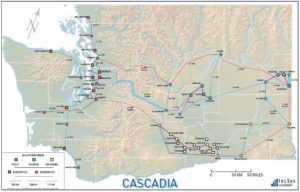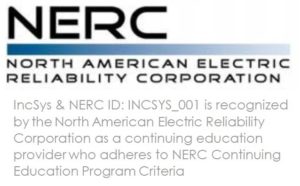Transmission Lines
Course NERC CE Hours: OT: 2; Stand: 1.5; SIM:1.5
This course is a computer based blended course of video lecture and simulation exercise to instruct students on the features of Transmission Lines in regards to voltage control on networks and surge impedance loading. They will also learn the characteristics of transmission lines in regards to voltage control on a network. The lecture will explain the behavior of transmission lines under various loaded conditions. Students will learn the definition and derivation of Surge Impedance Loading (SIL). Using the concept of SIL as a square function, students learn how severely MVArs are consumed or created based on the line loading and the SIL. Students will then apply what they have learned through a simulation exercise where they operate a hypothetical network and observe transmission lines characteristics at different loading levels. The students learn how MVAr gains and losses affect the voltage profile in order to predict the changes in voltage during the simulation exercise. Students will also learn the derivation of the Ferranti rise calculation, how the condition is caused, and the risks associate. They will also observe and record system conditions on different transmission lines in the network and record the MVAr reserves in the system and what are produced on a set of transmission lines. Students prepare to increase the load on those lines, and calculate the change in voltage and MVArs absorbed by transmission lines. They will also simulate contingencies by removed lines from service, loaded parallel lines 2x and 4x their SIL. During the contingencies, students monitor for IROL violations and record system conditions including voltage and MVAr reserves.
 Cascadia 5060 – Course Objectives
Cascadia 5060 – Course Objectives
Transmission Lines
- Define Surge Impedance Loading.
- Identify the conditions when transmission lines act as capacitors and reactors.
- Predict when increase and decrease of MVArs based on the MW loading of a transmission line.
- State the risks of overloading transmission lines.
- State the conditions that can cause Ferranti rise and risks associated with Ferranti rise.
- Observe transmission lines loaded to different levels of SIL and record values for voltage, MVAr, and MW flow.
- Predict the voltage and MVAr flow on transmission lines that are loaded 2x and 4x above the SIL.
- During simulation, respond to the loss of parallel transmission lines by monitoring contingency analysis, MVAr reserves, and network voltage.
- Record the change in system conditions and compare to previous calculated conditions.
Downloadable 5060 Course Flyer
Subject Matter Expert
This course listed is a NERC CE approved continuing education course which will help you obtain the required NERC CE Credit Hours for maintaining the validity of your NERC Certification.
End of Course Instructions
After successful completion of the course the certificate of completion will be available for download and print from your training homepage.
After successful completion of this course your credits will be automatically reported for NERC CE Credits via the NERC SOCCED reporting tool. IncSys Academy also has a policy where credits will be manually reported via SOCCED on a WEEKLY basis (every Monday). It is critical that each candidate provide IncSys Academy with their proper credentials to ensure that proper credits are reported to your SOCCED account. Please contact our team at 425.732.2377 X 3 or via email at calvin.kaiser@incsys.com to report any NERC CE credit items needed for resolution.
Quiz & Simulation Information
There are quizzes and simulation exercises in this course module which must be passed with a MINIMUM grade of 75% to complete the course. Please check your grade report to ensure that you have achieved a passing grade of at least a 75% for each graded area.
IncSys Non-Refundable Policy
Clients who purchase training from the IncSys Academy catalog portal are Non-Refundable from the date of payment. Please ensure that you copy and save your receipt order prior to closing out your purchase order payment.

